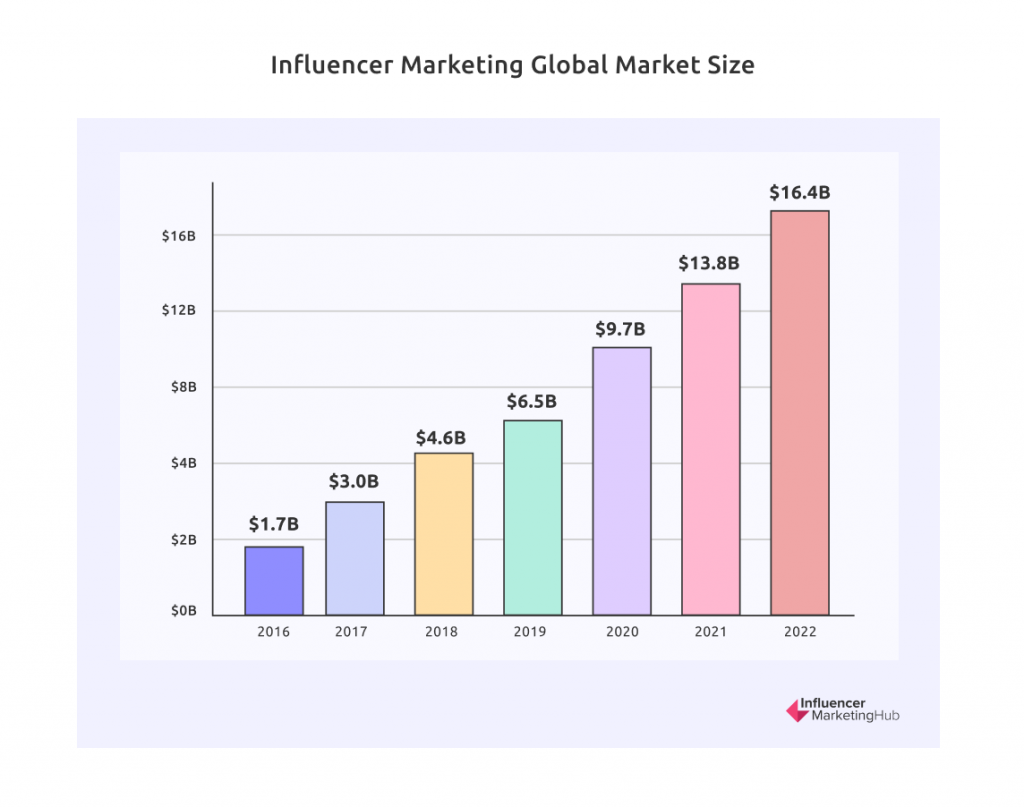During Covid, influencer-boosted marketing campaigns took on a decidedly different look and feel with its own set of unique challenges for connecting—and reconnecting—with audiences. Now that things are getting back to normal-ish, will influencer marketing have even more of an impact on brands?
Let’s take a look at the real influence of influencers.

The Influencer Connection
One thing’s for certain. Influencers continued to play a huge part in campaigns as people searched for authentic connections online outside of the always awkward employee Zoom happy hours. Influencer-based brand messaging reigned supreme on social media and even increased influencer credibility with their already loyal followers.
This year, according to stats from Influencer Marketing Hub, the influencer marketing industry is set to reach $16.4B. As a testament to the strategic importance of influencers, nearly two-thirds of businesses say they’ll increase their 2022 influencer budget.
Over half of brands prefer to develop long-term influencer partnerships as opposed to special guests—a smart move, to be sure. While hiring a different influencer for each new campaign may work in the short term, ongoing relationships tend to be stronger and more consistent, putting a recognizable face to a personal brand.
From Nano to Mega and Back Again

Depending on the nature of your marketing campaign, your budget, and your audience, there are a number of influencers to choose from. Five, to be exact, according to Instagram, which lines up with other agreed upon tiers.
- Mega-influencers/celebrities
- Macro-influencers
- Mid-tier influencers
- Micro-influencers
- Nano-influencers
Micro-influencers have increasingly become the go-to influencers, with a follower count usually under 50,000. In fact, the market share of micro-influencers continues to grow. In 2021, for instance, the market share for micro-influencers was 91%. Engagement rates can tell you a lot more than sheer number of followers (which can be purchased by influencer wannabes).
The micro-influencer tends to have more of a niche audience, lending itself to accelerated targeted messaging and richer audience engagement. On Instagram, for example, micro-influencers boast an average engagement rate of 3.86%. In comparison, mega-influencers only hit a 1.2% rate.
If the audience feels a true authentic connection to an influencer, there’s already a level of trust underlying any third-party promotion. And both micro-influencers and nano-influencers carry the added bonus of being far less expensive than just one mega-influencer.
Some examples of popular types of promotional campaigns featuring micro-influencers include product reviews; discount marketing campaigns (i.e. coupon codes); and contests/giveaways.
There may just be five main types of influencers for now but the micro-influencer market is becoming über-niche, from skincare influencers (skinfluencers) to pet influencers (petfluencers). It also helps if you happen to have a spider monkey handy.
Channeling the Influencer
When you’re deciding where to find the best influencers for your marketing campaigns, researching their presence on social media and analyzing their audience and expertise is a good place to start. An estimated 67% of users who follow brands and influencers on social say they are more likely to increase their spending with that specific brand.
Although Instagram and Instagram Stories continue to make up the preferred social media channel for influencer marketing, TikTok has steadily increased its share of the market, gaining in popularity during Covid. TikTok, which caters mostly to Gen Z, is an ideal platform for micro-influencer marketing. Instagram Reels, on the other hand, is more popular with millennials.

A study conducted by influencer platform Mavrck referred to TikTok as the birthplace for viral content, and it’s easy to see why. Today’s creative TikTok users could be tomorrow’s influencers.
Among Gen Z YouTube subscribers, the real celebrities are their YouTube stars. They find them more relatable and trustworthy as opposed to, say, Kylie Jenner. Although YouTube is not the preferred social media for influencer marketing, connections there are seen as more genuine with Gen Z. According to research from Altimeter, the five most influential personalities among American teens are, in fact, all YouTubers, more so than celebrities like Jennifer Lawrence and Seth Rogen.
And even though it doesn’t make the top four influencer channels, don’t write off Twitter completely. According to USP Solutions, nearly 40% of Twitter users have made a purchase as a direct result of an influencer tweet.
Will the Right Influencer Please Stand Up?

Finding just the right influencer for your brand, strategy and audience can be tricky. Establishing a collaborative relationship with an influencer
—especially a micro-influencer —is critical to putting a familiar and trusted face on any long-term campaign.Allowing influencers to be themselves is a must. The reason they have the audience they do is because the audience likes them and respects their opinion. And when they do represent your brand in a transparent manner, their followers are more likely to pay attention.
Photo by ABDALLA M on Unsplash


0 Comments